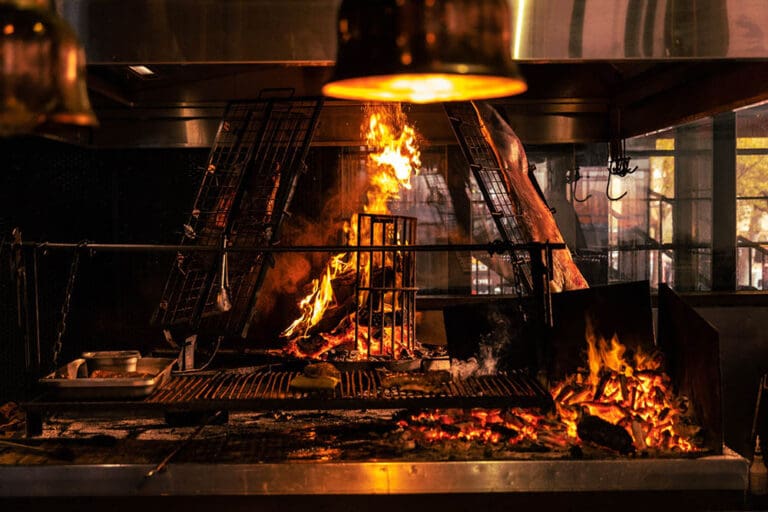Argentina is known for its vibrant culture, rich history, and delicious cuisine. One of the most iconic and beloved aspects of Argentine culture is the asador, a traditional style of cooking that has been passed down for generations. An asador is a wood-fired grill, typically made of brick or clay, used for cooking a variety of meats and vegetables. It is not just a method of cooking, but a way of life in Argentina, representing family, community, and tradition.
The origins of the asador
The asador has its origins in Spanish colonizers who brought the tradition of grilling meat to Argentina in the 16th century. However, the true origins of the asador can be traced back to the Gauchos, the nomadic cowboys of the Argentine Pampas (grasslands). The Gauchos were skilled in the art of cooking over an open fire, known as a “fuego de campo.” They would use metal crosses to roast whole animals such as cattle and wild boar over the fire. This method of cooking was not only practical for these nomadic people but also reflected their way of life, as they had a strong connection to the land and the animals they raised. The word “asador” comes from the Spanish word “asar,” meaning “to roast.” Over time, it evolved from a simple metal cross to a more complex structure made of brick or clay. This allowed for more control over the fire and temperature, resulting in a better cooking experience. It became a staple in the culinary and cultural landscape of Argentina, with families passing down their techniques and recipes from generation to generation.
How the asador is used
The asador is primarily used for cooking meats, but it is also suitable for vegetables and other dishes. The fire is usually started a few hours before cooking to allow the wood to burn down to embers, providing a constant and even heat source. Different types of wood are used to impart different flavours to the food. For example, logs from fruit trees such as apple or peach can give the meat a sweet and smoky flavour, while oak and mesquite are more intense and provide a bold flavour. Meats are usually seasoned with just salt and often left to marinate for a few hours before cooking. This allows it to penetrate the meat and renders it more tender. Once the fire has reached the perfect temperature, the meat is placed on a grill over the hot coals. The asador usually has multiple grills, allowing different cuts of meat to be cooked at the same time. The meat is cooked slowly, turning it occasionally to ensure even cooking. The slow roasting method allows the meat to retain its juices, resulting in tender and flavour-packed cuts of meat.
What is cooked on the asador?
Argentinian cuisine is known for its love of meat, and the asador is the perfect tool for cooking it to perfection. One of the most popular meats cooked on the it is asado, or grilled beef. Asado is typically a mix of different cuts of beef, including ribs, skirt steak, flank steak, and sweetbreads. These cuts of meat are seasoned with just salt and cooked slowly until they are juicy and tender. Another popular dish cooked is churrasco, which is a cut of beef from the ribeye or sirloin known for its tenderness and marbling. Churrasco is typically served with chimichurri, a delicious sauce made from parsley, garlic, olive oil, and other herbs and spices. Other meats commonly cooked include chorizo sausages, which are made with a blend of pork and spices, and morcilla, a blood sausage that is popular in Argentina. Vegetables such as potatoes, peppers, and onions are also often cooked, taking on a smoky flavour that pairs perfectly with the meats.
The symbolism of the asador in Argentine culture
The asador holds significant symbolism in Argentine culture, representing tradition, family, and community. In Argentina, the Sunday asado (meal cooked on the asador) is a sacred institution, a time for families and friends to gather and share a meal. It is often a full-day affair, with the fire being started early in the morning and the cooking going on all day. This tradition brings generations together, with grandparents passing down their recipes and techniques to their grandchildren. The asador is also a symbol of the Argentine lifestyle. The Gauchos, who were once the embodiment of the Argentine way of life, used it to cook their meals. Today, the asado is still a way for Argentines to connect with their roots and honour their heritage.
Social aspect of the asador
The asado is not just a meal, but a social event. It is a time for bonding, storytelling, and laughter. In Argentina, it is said that the asador represents a way of life, where time is taken to appreciate good food, good company, and the simple pleasures in life. The asado is a celebration, a chance for people to come together and forget their worries. There are certain customs and rituals associated with the asado, making it a unique and memorable experience. For example, once the meat is cooked, it is usually served on a large wooden board called a tabla and is passed around to each guest. The person carving the meat is considered a position of honour and is usually the father or grandfather of the family. The guests are also encouraged to participate in the cooking process, whether it be tending to the fire or flipping the meat. The asado is also a social leveller. In Argentina, it is common for people of all classes to come together for an asado, sitting at the same table and sharing the same food. There is a saying in Argentina that “meat is for everyone,” emphasizing the egalitarian nature of the asado.
Modern takes on the asador
While the asador remains a cherished tradition in Argentina, it has also evolved with the times. In recent years, chefs and restaurants have started to put a modern twist on this traditional cooking method. In urban areas, asadores can now be found in the form of a parilla, or grill, which is often gas or electric-powered. This allows for easier usage in smaller spaces and a more convenient cooking experience. However, many purists argue that the use of modern technology takes away from the traditional asado experience.
Summary
The Argentine asador is more than just a tool for cooking meat; it is a cultural institution that represents tradition, family, and community. Its origins can be traced back to the Gauchos of the Pampas, and it has since become a beloved pastime and way of life in Argentina. The slow roasting method used on the asador results in succulent and flavourful meats, making it an essential part of Argentine cuisine. The symbolism of the asador in Argentine culture highlights the importance of family, tradition, and the simple pleasures in life. The asado is not just a meal but a social event, bringing people together and creating lasting memories. While the asador may have evolved with the times, its deep-rooted traditions and customs continue to make it a beloved and integral part of Argentine culture.


